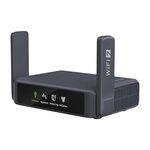More of the popular GL.iNet WiFi travel routers on sale with the coupons redeemable under the price for each one.
GL.iNet Slate 7 (GL-BE3600) travel router features WiFi 7 (no 6GHz) with 688Mbps (2.4GHz) & 2882Mbps (5GHz) front touchscreen interface, 2.5GbE LAN, 2.5GbE WAN, power via USB-C PD and an upgraded Qualcomm quad-core CPU paired with 1GB RAM and 1GB storage. Additionally there's a USB 3.0 port.
GL.iNet Flint 2 (GL-MT6000) router features AX6000 WiFi 6 4x4 (2.4GHz: 1148Mbps, 5GHz: 4804Mbps), two 2.5GbE network ports with both being able to be used as WAN ports for a secondary connection, failover etc, four 1GbE LAN ports, USB 3.0 port, 4 antennas and a multi plug charger.
These are particularly good due to OpenWrt compatibility, VPN support, Wireguard support, VLAN support and more. Possible use cases include AdGuard for network level adblocking, protecting yourself against unsafe networks such as hotel WiFi networks, or as dangerdanger describes a second WiFi network for the kids with Open DNS to filter out 'bad' content. I'm sure others can provide other suggestions in the comments.



 CamelCamelCamel
CamelCamelCamel

Nice!